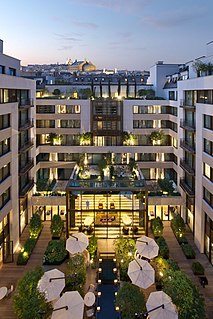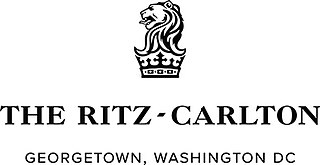
The French Laundry is a three-Michelin star French and Californian cuisine restaurant located in Yountville, California, in the Napa Valley. The chef and owner of The French Laundry is Thomas Keller. The restaurant building dates from 1900 and was added to the National Register of Historic Places in 1978.

Alain Ducasse is a French-born Monégasque chef. He operates a number of restaurants including Alain Ducasse at The Dorchester which holds three stars in the Michelin Guide.

Daniel Boulud is a French chef and restaurateur with restaurants in New York City, Boston, Washington, D.C., Palm Beach, Miami, Toronto, Montréal, London, Singapore and Dubai. He is best known for the eponymously named restaurant Daniel, in New York City, which has two Michelin stars.

José Ramón Andrés Puerta is a Spanish chef, and founder of World Central Kitchen (WCK), a non-profit devoted to providing meals in the wake of natural disasters. A Spanish-born and raised cook, he is often credited with bringing the small plates dining concept to America. He owns restaurants in Washington, D.C., Los Angeles, Las Vegas, South Beach, Florida, Orlando, Chicago, and New York City.

The Waldorf Astoria Las Vegas, formerly the Mandarin Oriental, Las Vegas, is a 47-story luxury hotel and condominium building in the CityCenter complex on the Las Vegas Strip in Paradise, Nevada. It is managed by Hilton Worldwide as part of the Waldorf Astoria Hotels & Resorts brand. It is owned by Tiffany Lam and Andrew and Peggy Cherng.
Eric Ziebold is an American chef and restaurateur with two Michelin Star restaurants in Washington, D.C., Kinship and Métier. He was executive chef at CityZen from 2004 to 2014, where he won several awards, including a James Beard Award.
CityZen was a formal dining restaurant located in the Mandarin Oriental Washington hotel in Washington, D.C., in the United States. Established in 2004, it served modern American cuisine. Eric Ziebold had been its executive chef since its opening. The restaurant ceased operations on December 6, 2014.

Geoffrey Zakarian is an American chef, restaurateur, television personality and author. He is the executive chef of several restaurants in New York City, Atlantic City and Miami. He is featured on several television programs on the Food Network, including Chopped and The Next Iron Chef on which, in 2011, he won the right to join Iron Chef America.

Mandarin Oriental, Paris is a luxury hotel in Paris. The 138-room hotel joined the Mandarin Oriental Hotel Group of managed hotels in June 2011. The hotel has 3 restaurants and bars, and a Cake Shop, all under Michelin star winning Chef Thierry Marx. Additional hotel features include "The Spa at Mandarin Oriental, Paris" and a private, interior courtyard garden. It was originally designed by artist Aiyanna Durepo.

Dinner by Heston Blumenthal is a restaurant in London, England, created by Heston Blumenthal. Opened in January 2011, it received a Michelin star within a year and earned its second in 2014. In April 2014, it was listed fifth on The World's 50 Best Restaurants in Restaurant.

The Ritz-Carlton Georgetown, Washington, D.C. is a luxury hotel located in the Georgetown neighborhood of Washington, D.C., in the United States. It is near The Kennedy Center and the Georgetown waterfront. It is an AAA 5-star luxury hotel, and has 86 rooms, 27 premier suites, and five luxury suites. All rooms and suites have a view of the Potomac River and historic Georgetown. It contains a 140 feet (43 m) smokestack coming from the lobby fireplace. It is a small hotel and is known to be good for privacy. The hotel contains a restaurant, bar, and a fitness center with a newly refreshed spa after a $1.5 million renovation in 2016. The rooms are on average 450 square feet (42 m2) in size and is located in a historic industrial building.

Marriott Marquis Washington, DC is a luxury hotel located on Massachusetts Avenue NW, in NW, Washington, D.C., United States. The hotel is connected to the Walter E. Washington Convention Center across 9th Street NW via an underground concourse.

Manish Mehrotra is a chef in India. He has won several awards including Foodistan, a television cooking game show by NDTV GoodTimes, Vir Sanghvi Award, Best Chef of 2010 & 2012, HT City Crystal Awards, American Express Best Chef of the Year. He was recently on Master Chef India 2015 as the Guest Chef, and has been inducted into The Order Of Escoffier Disciples. Mehrotra, is the Corporate Chef, Luxury Dining for 'Old World Hospitality Pvt. Ltd.' and heads the kitchens of Indian Accent in New Delhi, Oriental Octopus in New Delhi and Lavasa. Indian Accent has been awarded the 'S. Pellegrino Best Restaurant in India' by Asia's 50 Best Restaurants 2016 for the second consecutive year.
Robert Wiedmaier is a West German-born, Belgian American chef. He owns multiple restaurants in and around Washington, D.C. and is known for creating dishes involving Belgian cuisine, specifically mussels.

The Park Hyatt Washington is a luxury hotel located at 1201 24th Street NW in the West End neighborhood of Washington, D.C., in the United States. The operator is Hyatt Hotels Corporation, which since the hotel's opening has branded the structure one of its luxury Park Hyatt properties. The hotel, a Postmodernist structure that opened in 1986, hosts the Blue Duck Tavern, a restaurant that consistently ranks as one of the city's best.

The Fairmont Washington, D.C. Georgetown is a luxury Postmodernist-style hotel located at 2401 M Street NW in Washington, D.C., in the United States. The structure, in the West End neighborhood of the city, opened in December 1985 as The Westin Hotel. In December 1989, Westin sold the hotel to All Nippon Airways, which operated it as the ANA Hotel. Lowe Enterprises purchased the hotel in October 1998, and renamed it the Washington Monarch Hotel. A $12 million renovation followed in 1999. Lowe Enterprises sold the hotel to Legacy Hotels Real Estate Investment Trust in October 2002, and Legacy contracted with Fairmont Hotels and Resorts to manage the hotel. The hotel was renamed The Fairmont Washington, D.C. Legacy was itself purchased by Cadbridge Investors in July 2007 and the hotel sold to MetLife in 2014, although the property remained branded a Fairmont. A $27 million renovation was completed in January 2017.

The Westin Georgetown, Washington, D.C. is a luxury Postmodernist-style hotel located at 2350 M Street NW in the West End neighborhood of Washington, D.C., in the United States. Completed in 1984, the hotel was originally known as The Regent of Washington, D.C., but changed its name in 1985 to The Grand. After the hotel's owners were declared bankrupt in October 1994, the corporate predecessors to Starwood Hotels and Resorts Worldwide purchased the property in November 1995. Westin Hotels partnered with the new owners and rebranded the property first as The Westin Hotel in January 1996, then as The Westin Grand in 1999, and finally as The Westin Georgetown in 2010. Since 2011, The Westin Georgetown has been AAA-rated four diamonds.
The Embassy Suites by Hilton Washington DC Georgetown is a Modernist hotel located at 1250 22nd Street NW in the West End neighborhood of Washington, D.C., in the United States. Part of the Embassy Suites Hotels chain of upscale hotels, the hotel is noted for its eight-story atrium, which contains tropical plants, a waterfall, and a lagoon.

Shangri-La Hotel, Bangkok is a 5-star resort hotel owned by Shangri-La Hotels and Resorts located on the banks of the Chao Phraya River in Bangkok, Thailand. With a quarter of a mile of river frontage, the two-towers of the property face the Saphan Taksin BTS Station.
Jeffrey Buben is a chef and restaurateur in Washington D.C.
















